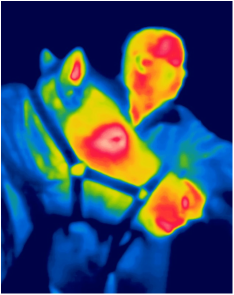Thermal Imaging

What is Thermal Imaging?
Thermal imaging is a useful tool for identifying areas which show surface temperature anomalies. Using the infrared part of the light spectrum which is invisible to the human eye, images are taken with both the infrared camera and the visible light camera simultaneously. This ensures that images can be compared and anomalies associated with the correct area using a more familiar picture.
A benchmark report will always be carried out in the first instance and comparison reports can be carried out thereafter. For benchmarking it is preferable if the horse is free from injury or ailment, however this is not essential. Comparison reports are exactly that; images are compared to the benchmark report and differences noted.
Thermal imaging is completely hands off and a non-invasive diagnostic aid. I do not diagnose whether your horse does or does not have any given condition however I will identify areas of thermal patterns on the images. Thermal imaging does not replace the need for a vet, but the reports may help guide your vet. I am always happy to discuss images with your vet and will ask who your vet is before the imaging takes place.
Preparation of the horse for an imaging session
For best results and for better, more meaningful images please note the following:
- The use of NSAID drugs (such as Bute or Danilon) and other anti-inflamatories will reduce the heat in areas of interest and should not be fed for 2 days prior to imaging if a comparison report is required.
- Thick, hairy coats and feathers reduce emissivity (the horses ability to emit heat). If you wish to hog or clip the horse this should not be done within 24 hours of imaging.
- Do not pull the mane or tail within 24 hours of the imaging to allow time for the skin to settle and blood flow in the area to return to normal.
- Do not use creams or sprays within 24 hours of the imaging as they can mask the heat patterns.
- Horses must be clean, dry and mud free including hooves being clean and picked out. Mud will hide the heat and may cause unnecessary concern as it will show as a cold area.
- Do not exercise or groom the horse within 2 hours of the imaging. Both alter the blood flow in the soft tissues and as such can give false readings.
- Manes and tails should be plaited to expose the neck and quarters. This should be done at least an hour before imaging to allow for those areas usually covered to be as temperature neutral as possible.
- Rugs and bandages and headcollars must be removed at least an hour before imaging. Friction and insulation from rugs and bandages will also give false readings, usually around the shoulders and pint of hips, so the body needs time to normalise its’ temperature. Headcollars cover some important structures and it is best if the head can be imaged before putting the headcollar on.
- Images are best taken when out of draughts or direct sunlight such as in a large stable, barn or indoor school. Subjects should be in location at least 20 minutes before the imaging. Sufficient room will be required for the camera to be up to 3 metres away from the horse. It is best if the floor is level, flat and non-slip such as rubber matting or sand.
- Do not touch a horse on an area that has yet not been imaged as this will leave a thermal imprint which can distort or falsify results.
Before a session Jo will ask for details which can be answered prior to the session by completing and emailing this form.
How much does Thermal Imaging cost?
Full body scan and benchmark report: £75 per horse.
Full body scan and comparison report: £110 per horse.
Milage is applied at 50p/mile over the first 10 miles.